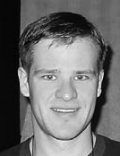Projects
Access to Success: A Guide for Employers

“People with disabilities really add diversity to the workforce,” Fehr says. “It shows people with disabilities can have productive careers, and shows the company is an inclusive employer, that they don’t discriminate based on ability.” |
Profile: Jacob Fehr
Software Developer
By Neil Faba
Jake Fehr’s business card may list his occupation as Software Developer, but appearances can be deceiving.
Fehr says that a typical workday in Shaw Communications’ Calgary office involves “a bit of everything”. In addition to performing development work on new software projects, he says his day usually also involves some support work on existing software, conducting bug fixes on the company’s Pay-Per-View technology, and performing product support, as well as other duties.
“The good thing about it is it’s not cookie-cutter,” says Fehr of his job. He says the fact there is only a small number of employees in his department has presented him with the opportunity to experience such a broad range of duties. “If we had a bigger staff, I would just be a software developer.”
Fehr, who has a visual impairment, says he found his current job thanks to an internship opportunity. He says being able to get a foot in the door through internship allowed him to gain knowledge and experience in an industry he had no previous background in outside of his studies.
An internship at Shaw, Fehr says, also allows young people the chance to work on projects that would normally be reserved for those who’ve been with the company for a number of years. This creates potential employees who possess a vast knowledge of the company once the internship has ended.
“Once our interns are done, they move on to a lot of responsibility,” he says. “They learn a lot in 8 to 12 months.”
Fehr says that it’s true that experience is important in many jobs, given the contacts and knowledge long-term players in an industry can bring to a company. But, he adds, employers should also realize that experience isn’t all that’s important. While students right out of school may not have years of employment in their chosen field, more often than not, they possess the key skills and attributes that make up a valuable employee.
One of the challenges many people with disabilities face when hunting for employment is the decision of whether to disclose their disability to a potential employer. Fehr says he always discloses, but chooses to wait until the end of a job interview before mentioning he has low vision. He says he simply explains the disability, and how it might effect how he conducts the duties of the job. “I think that way, the employer focuses on the interview, rather than the disability,” says Fehr.
Another workplace challenge, both for employees with disabilities and their employers, is the issue of accommodations. Fehr says that, overall, he has had good experiences in seeking accommodations from employers. Most of the time, he is able to get around his disability by simply moving closer to the information he is reading or viewing, but he says that his supervisors at Shaw further accommodated him, without his even asking, by giving him a 21-inch monitor to work with, early in his tenure with the company. He now has two large screens at his disposal.
He says employers should realize that accommodating employees with disabilities isn’t always an expensive or time-consuming venture. “There are less expensive alternatives in some cases,” he says, “you just have to look and do some research.” For example, Fehr says he found a video card that allowed him to zoom in on computer images, which was much cheaper than the ZoomText software that many people with visual impairments use.
Fehr says that both people with disabilities and employers need to work together to understand each other’s needs and abilities. People with disabilities need to focus on their own skills and abilities, rather than their disabilities, and need to build the confidence required to sell themselves to employers. Employers, in turn, need to be willing to put aside any preconceived notions, and be willing to take a risk on someone who may not fit the typical mould of a new employee.
Fehr says there are a few people with mobility or visual impairments at Shaw, which creates a positive environment within the company.
“People with disabilities really add diversity to the workforce,” he says. “It shows people with disabilities can have productive careers, and shows the company is an inclusive employer, that they don’t discriminate based on ability.”

 Quick Question:
Quick Question:

